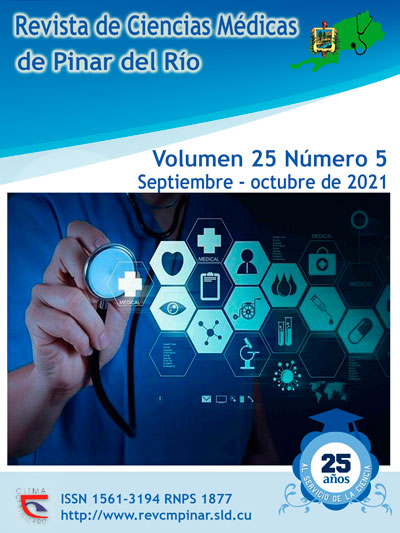Clinical and epidemiological characterization of basal cell carcinoma at Celia Sanchez Manduley Clinical Surgical Teaching Hospital, 2017- 2019
Keywords:
CARCINOMA, BASAL CELL, SKIN NEOPLASMS, RISK FACTORS¸ PATHOLOGY, EYELIDS.Abstract
Introduction: basal cell carcinoma represents approximately 70 to 80% of non-melanoma skin cancers, it is a malignant tumor of epithelial origin, and its growth is slow and rarely metastasizes.
Objective: to characterize the clinical and epidemiological variables of patients with basal cell carcinoma.
Methods: a descriptive, cross-sectional and observational study was carried out in 159 patients diagnosed with basal cell carcinoma, attended Maxillofacial Service at Celia Sánchez Manduley Clinical Surgical Teaching Hospital, Manzanillo province, from the period December 2017 - December 2019. The following variables were studied: age, sex, skin color, origin, location, clinical forms and surgical technique performed. Descriptive statistics was applied in the research.
Results: the most affected group was the seventh decade of life (23,3 %), with a slight predominance of female sex (55,3 %). Most of the patients with basal cell carcinoma were white skinned (54,7 %), the rural population was the most affected (56 %). The nasal region was the most damaged (37,7 %), the nodular pearly clinical form (49,7 %) was the predominant one and most patients were treated with simple excision (64,8 %).
Conclusions: basal cell carcinoma predominated in females, mostly in patients with white skin, of rural origin and the most damaged area was the nose. The main risk factor for this disease is exposure to ultraviolet radiation, hence the importance of prevention and photo-protection from childhood.
Downloads
References
1. Castellano Maturell G, Nápoles Pastoriza DD, Niebla Chávez R, Berenguer Gouarnaluses M, Sánchez Álvarez JE. HeberFERON® en el tratamiento del carcinoma basocelular. Informe de caso. 16 de Abril [Internet]. 2019 [citado 07/03/21]; 58(271): 25-28. Disponible en: www.rev16deabril.sld.cu/index.php/16_04/article/view/776
2. Diagnóstico y Tratamientodel Carcinoma Basocelular. Guía de Evidencias y Recomendaciones:Guía de Práctica Clínica. México, CENETEC [Internet]. 2019 [citado 07/03/21]: [aprox. 55p.]. Disponible en: http://www.cenetec-difusion.com/CMGPC/GPC-IMSS-360-19/ER.pdf
3. Azulay DR, Azulay RD. Dermatología. 6 ed. Rio de Janeiro: Guanabara Koogan; 2013. p.1156.
4. Kauvar AN, Cronin T Jr, Roenigk R, Hruza G, Bennett R. American Society for Dermatologic Surgery. Consensus for Nonmelanoma Skin Cancer Treatment: Basal Cell Carcinoma, Including a Cost Analysis of Treatment Methods. American Society for Dermatol Surg [Internet]. 2015 [citado 07/03/21]; 41(5): [aprox. 21p.]. Disponible en: https://doi.org/10.1053/j.seminon-col.2018.04.007
5. Darias Domínguez C, Garrido Celis J. Carcinoma basocelular. Un reto actual para el dermatólogo. RevMéd Electrón [Internet]. 2018 Ene-Feb [citado 07/03/21]; 40(1): [aprox. 10 p.]. Disponible en: http://www.revmedicaelectronica.sld.cu/index.php/rme/article/view/2498/3707
6. Viñas García M, Algozaín Acosta Y, Álvarez Campos L, Quintana Díaz J C. Comportamiento del carcinoma basocelular facial en Artemisa durante la última década. Revista Cubana de Estomatología [Internet]. 2011[citado 07/03/21]; 48(2): 121-128.Disponible en: http://scielo.sld.cu/pdf/est/v48n2/est04211.pdf
7. Ariza S, Espinosa S, Naranjo M. Terapias no quirúrgicas para el carcinoma basocelular: revisión. ActasDermosifiliogr [Internet]. 2017 [citado 07/03/21]; 108(9): [aprox. 8p.]. Disponible en: https://www.actasdermo.org/es-pdf-S0001731017301187
8. Bichakjian C, Armstrong A, Baum C, Bordeaux JS, Brown M, Busam KJ, et al. Guidelines of care for the management of basal cell carcinoma. J Am AcadDermatol. [Internet] 2018 [citado 07/03/21]; 78(3): [aprox 559p.]. Disponible en: https://www.sciencedirect.com/science/article/pii/S019096221732529X?via%3Dihub
9. Dias da Silva R, Inácio Dias MA. Incidência do carcinoma basocelular e espinocelular em usuários atendidos em um hospital de câncer REFACS. [Internet] 2017 [citado 07/03/21]; 5(2): 228-34. Disponible en: https://www.redalyc.org/journal/4979/497952553007/497952553007.pdf
10. Dirección de registros médicos y esta¬dísticas de salud. Anuario estadístico de salud 2016 [Internet]. 2017 [citado 07/03/21]: [aprox 193p.]. Disponible en: https://data.miraquetemiro.org/sites/default/files/documentos/Anuario_Estad%C3%ADstico_de_Salud_e_2016_edici%C3%B3n_2017.pdf
11. Fonseca Andino DC, Sánchez Gutiérrez RA. Cáncer de piel en pacientes un policlínico de Manzanillo. 2016-2017. RevMultimed. [Internet]. 2018 [citado 07/03/21]; 22(5): [aprox 10p.]. Disponible en: https://www.medigraphic.com/pdfs/multimed/mul-2018/mul185h.pdf
12. Madan V, Lear JT, Szeimies RM. Non-melanoma skincancer. Lancet [Internet]. 2010 [citado 07/03/21]; 375(9715): [aprox. 11p.]. Disponible en: https://pubmed.ncbi.nlm.nih.gov/20171403/
13. García Massó D, Cruz Setien R, Rimblas Casamor C, Menéndez Rodríguez M, Samada Durán TL. Caracterización clinicoepidemiológica de pacientes con tumores epiteliales cutáneos no melanoma. Medisan. [Internet]. 2019 [citado 07/03/21]; 23(2): 260. Disponible en: http://www.medisan.sld.cu/index.php/san/article/view/2629
14. Alfaro A CL, Rodríguez M. Cáncer de piel. Estudio epidemiológico a 10 años en derecho habientes del ISSTE en Nuevo León. Dermatología RevMex. [Internet] 2010 [citado 07/03/21]; 54(6): 321-25. Disponibleen: https://www.medigraphic.com/cgi-bin/new/resumen.cgi?IDARTICULO=28038
15. Romano MF, Chirino ME, Rodríguez Saa S, Pedrozo L, Lauro MF, Ciancio RM. et al. Carcinoma basocelular superficial y sus características dermatoscópicas de acuerdo con su localización. Med Cutan Iber Lat Am [Internet]. 2016 [citado 07/03/21]; 44(3): [aprox 6p.]. Disponible en: http://www.medigraphic.com/pdfs/cutanea/mc-2016/mc163d.pdf
16. Amaya Nieto LM, Sierra Patiño LF, Pérez Estepa HH. Actualización en carcinoma basocelularperiocular: abordaje semiológico y diagnóstico diferencial. CiencTecnol Salud Vis Ocul [Internet]. 2019 [citado 07/03/21]; 17(1): 45-56. Disponible en: https://doi.org/10.19052/sv.vol17.iss1.4
Downloads
Published
How to Cite
Issue
Section
License
Authors who have publications with this journal agree to the following terms: Authors will retain their copyrights and grant the journal the right of first publication of their work, which will be publication of their work, which will be simultaneously subject to the Creative Commons Attribution License (CC-BY-NC 4.0) that allows third parties to share the work as long as its author and first publication in this journal are indicated.
Authors may adopt other non-exclusive license agreements for distribution of the published version of the work (e.g.: deposit it in an institutional telematic archive or publish it in a volume). Likewise, and according to the recommendations of the Medical Sciences Editorial (ECIMED), authors must declare in each article their contribution according to the CRediT taxonomy (contributor roles). This taxonomy includes 14 roles, which can be used to represent the tasks typically performed by contributors in scientific academic production. It should be consulted in monograph) whenever initial publication in this journal is indicated. Authors are allowed and encouraged to disseminate their work through the Internet (e.g., in institutional telematic archives or on their web page) before and during the submission process, which may produce interesting exchanges and increase citations of the published work. (See The effect of open access). https://casrai.org/credit/



